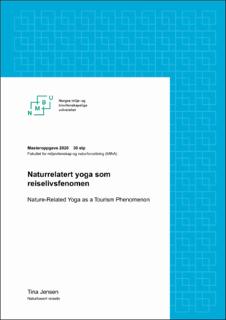| dc.contributor.advisor | Haukeland, Jan Vidar | |
| dc.contributor.author | Jensen, Tina | |
| dc.coverage.spatial | Norway | en_US |
| dc.date.accessioned | 2020-10-05T08:51:26Z | |
| dc.date.available | 2020-10-05T08:51:26Z | |
| dc.date.issued | 2020 | |
| dc.identifier.uri | https://hdl.handle.net/11250/2681076 | |
| dc.description.abstract | Denne masteroppgaven tar for seg naturrelatert yoga som reiselivsfenomen, det jeg har valgt å kalle «naturrelatert yogaturisme». Yogareiser og naturbasert reiseliv er hver for seg i vekst, noe gjør det interessant å se nærmere på reiselivsprodukter som kombinerer både yoga- og naturopplevelser. I denne oppgaven ser jeg spesielt på tre aspekter: opplevelseselementer i et helhetlig naturrelatert yogaturismeprodukt, hva som kjennetegner en typisk yogaturist, samt hva som er sammenhengen mellom yoga og natur. Disse temaene belyses med utgangspunkt i tidligere studier, teorier og tekster innenfor yoga og yogaturisme, samt reiseliv og naturbasert reiseliv.
Naturrelatert yogaturisme kan forstås som en reise med hensikt om å praktisere yoga, hvor hele eller deler av aktivitetene og oppholdet for reisen foregår i naturomgivelser. Dillette mfl. (2019) har identifisert tre viktige pådrivere for transformative opplevelser blant yogaturister: aktiviteter, retreat-miljøet og naturomgivelser. Et helhetlig tema for reiselivsproduktet, hvor alle sanser og opplevelsesmåter aktiveres (Tarssanen og Kylänen, 2006; Kamfjord, 2015), men som også gir rom for frihet og alenetid under oppholdet (Dillette mfl., 2019), ser ut til å kunne bidra til en positiv samskaping av det helhetlige naturrelaterte yogaturismeproduktet.
Selv om yogaturister er forskjellige, vil «den typiske yogaturist» kunne beskrives som en kvinne i alderen 35 til 54 år, men høy utdannelse og høy inntekt, og som liker å holde seg i fysisk aktivitet. På yogareiser foretrekker hun å reise alene eller med venner, for å unngå kompromisser for hvor hun skal dra eller hva hun skal gjøre under oppholdet. Videre reiser hun helst til en naturbasert destinasjon ikke så langt hjemmefra eller til et strandhotell med varmt klima. Til slutt er hun gjerne en bevisst reisende som bryr seg om samfunn og miljø (Lehto mfl., 2006; Dillette mfl., 2019).
Sammenhengen mellom yoga og natur er spesielt tydelig i at yoga betyr forening – en forening mellom kropp sinn og sjel, men også mellom menneske og natur. | en_US |
| dc.description.abstract | This master’s thesis addresses nature-related yoga as a tourism phenomenon, what I will refer to as “nature-related yoga tourism”. Yoga tourism and nature-based tourism are separately growing in popularity, which makes it interesting to look into tourism products that combines both yoga and nature experiences. In this thesis, I focus on three aspects: the experience elements in an overall nature-related yoga tourism product, what characterizes a typical yoga tourist, as well as the connection between yoga and nature. I address these topics based on previous studies, theories and texts in yoga and yoga tourism, as well as tourism and nature- based tourism.
Nature-related yoga tourism can be understood as travel with the intention of practicing yoga, where all or parts of the activities and the stay for the journey takes place in natural surroundings. Dillette et al. (2019) identified three major drivers for transformative experiences among yoga tourists: activities, the retreat environment, and the natural environment. An overall theme for the tourism product, in which all senses and modes of experience are activated (Tarssanen & Kylänen, 2006; Kamfjord, 2015), but which also allow for recreation and time alone during the stay (Dillette et al., 2019), seems to contribute to a positive co-creation of an overall nature-related yoga tourism product.
Although yoga tourists are different, the “the typical yoga tourist” can be described as a woman aged 35 to 54 years old, who has higher levels of education and income, and enjoys physical activity. When traveling for yoga, she prefers to travel alone or with friends, to avoid compromises on where to go or what to do during the stay. Furthermore, she prefers to visit a nature-based destination not too far from home or beach resorts with warm climates. Finally, she is likely a conscious traveler who cares about society and the environment (Lehto et al., 2006; Dillette et al., 2009).
The connection between yoga and nature is particularly evident in that yoga means union – a union between body, mind and spirit, but also between us as humans and the nature that surrounds us. | en_US |
| dc.language.iso | nob | en_US |
| dc.publisher | Norwegian University of Life Sciences, Ås | en_US |
| dc.rights | Attribution-NonCommercial-NoDerivatives 4.0 Internasjonal | * |
| dc.rights.uri | http://creativecommons.org/licenses/by-nc-nd/4.0/deed.no | * |
| dc.subject | Yoga | en_US |
| dc.subject | Yogaturisme | en_US |
| dc.subject | Naturbasert reiseliv | en_US |
| dc.subject | Naturrelatert yogaturisme | en_US |
| dc.subject | Velværeturisme | en_US |
| dc.subject | Holistisk turisme | en_US |
| dc.subject | Nisjeturisme | en_US |
| dc.title | Naturrelatert yoga som reiselivsfenomen | en_US |
| dc.title.alternative | Nature-related yoga as a tourism phenomenon | en_US |
| dc.type | Master thesis | en_US |
| dc.description.version | submittedVersion | en_US |
| dc.subject.nsi | VDP::Samfunnsvitenskap: 200 | en_US |
| dc.source.pagenumber | 81 | en_US |
| dc.description.localcode | M-REIS | en_US |

